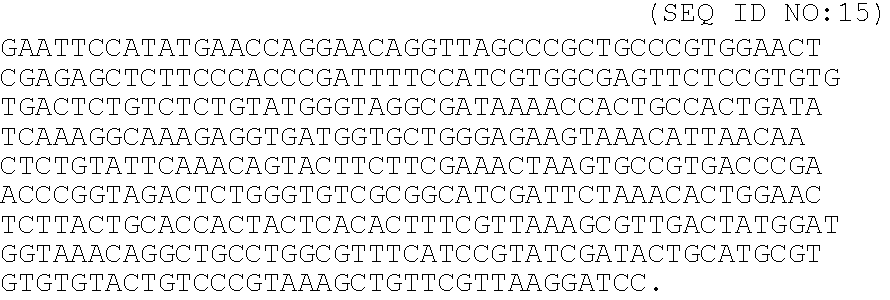Enzyme-mediated modification of fibrin for tissue engineering: incorporation of proteins
a technology of fibrin and enzymes, applied in the field ofmatrices, can solve the problems of altering the release of proteins, and achieve the effects of enhancing neurite outgrowth, promoting angiogenesis, and increasing neurite extension
- Summary
- Abstract
- Description
- Claims
- Application Information
AI Technical Summary
Benefits of technology
Problems solved by technology
Method used
Image
Examples
example 1
Indirect Coupling of Heparin Via a Heparin-binding Peptide to Attach Growth Factor
[0036]A peptide chimera containing both a factor XIIIa substrate and a heparin-binding domain is synthesized by standard solid phase synthesis. A sample peptide is one containing the following sequence, dLNQEQVSPK(βA)FAKLAARLYRKA (SEQ ID NO:12), where the N-terminus of the peptide contains the factor XIIIa substrate and the sequence in italics contains a modified peptide from the heparin-binding domain of ATIII (dL denotes dansyl leucine, which is used to allow detection of the peptide by fluorescence).
[0037]Size exclusion chromatography was used to determine the amount of peptide cross-linked to fibrin gels using the previously developed incorporation method. A bi-domain peptide containing the heparin-binding domain from antithrombin III and a fluorescent label was incorporated into fibrin gels during polymerization. The free peptide was washed from the gels, and the fibrin network was degraded with p...
example 2
Synthesis of Heparin-peptide Chimeras
[0038]A heparin-peptide chimera is synthesized by coupling a peptide, containing the factor XIIIa substrate on the N-terminus and a poly-lysine on the C-terminus, to a heparin oligosaccharide, with a unique aldehyde group on one end, via reductive amination. A peptide with the following sequence, dLNQEQVSPLKKKG (SEQ ID NO:13), is synthesized by standard solid phase peptide chemistry. The heparin oligosaccharides are made by standard nitrous acid degradation of heparin, resulting in the formation of an aldehyde on the reducing terminal of the cleaved oligosaccharide. During coupling, the ε-amino group of the lysine side chain attacks the aldehyde on the reducing end of the heparin oligosaccharide to form a Schiff base. The Schiff base is then reduced to form a stable product. A sample coupling protocol is given below.
Coupling Protocol:
[0039]1) Dissolve 1.8 mM of peptide and 1.8 mM of nitrous acid degraded heparin in 50 mM borate buffer, pH 9. Reac...
example 3
Degradable Sites in Fusion Protein and in Peptide Chimera
[0061]Fusion proteins or peptide chimeras, which are cross-linked to fibrin gels, may be further modified to contain a degradable site between the attachment site (i.e., factor XIIIa substrate or heparin-binding domain) and the bioactive protein (i.e., growth factor or enzyme). These sites may be degradable either by non-specific hydrolysis (i.e., an ester bond) or they may be substrates for specific enzymatic (either proteolytic or polysaccharide degrading) degradation. These degradable sites allow the engineering of more specific release of bioactive factor from fibrin gels. For example, degradation based on enzymatic activity allows for the release of bioactive factors to be controlled by a cellular process rather than by diffusion of the factor through the gel.
[0062]The degradation sites allow the bioactive factor to be released with little or no modification to the primary protein sequence, which may result in higher acti...
PUM
| Property | Measurement | Unit |
|---|---|---|
| bioactive | aaaaa | aaaaa |
| affinity | aaaaa | aaaaa |
| non-covalent interactions | aaaaa | aaaaa |
Abstract
Description
Claims
Application Information
 Login to View More
Login to View More - R&D
- Intellectual Property
- Life Sciences
- Materials
- Tech Scout
- Unparalleled Data Quality
- Higher Quality Content
- 60% Fewer Hallucinations
Browse by: Latest US Patents, China's latest patents, Technical Efficacy Thesaurus, Application Domain, Technology Topic, Popular Technical Reports.
© 2025 PatSnap. All rights reserved.Legal|Privacy policy|Modern Slavery Act Transparency Statement|Sitemap|About US| Contact US: help@patsnap.com



